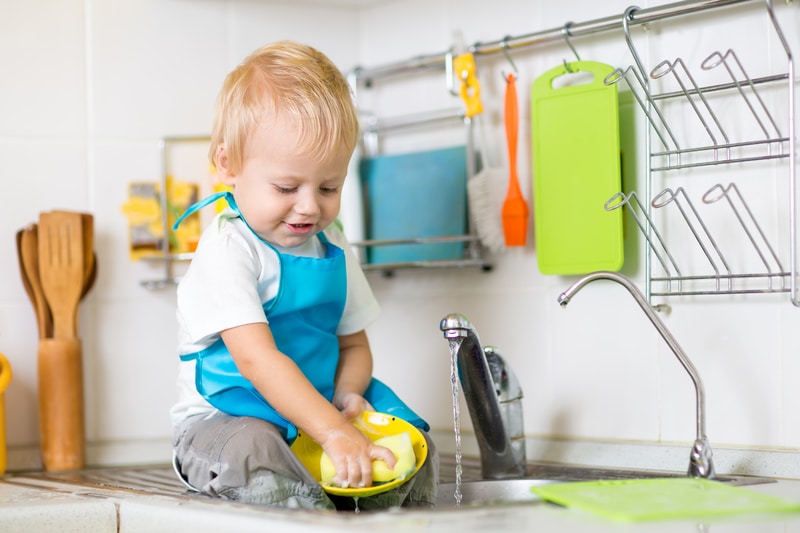
Welcome back to part 3 of our Non Toxic Kitchen series! If you missed them, make sure to go back and check out part 1 and part 2. Safe cooking, food prep and storage are, of course, super important, but our greatest toxin exposure in the kitchen is undoubtedly the chemicals we use to clean. As we wipe down our counters, scour our cutting boards and scrub our farmhouse sinks to keep things clean and safe, we’re unfortunately exposing our families to some pretty nasty toxic chemicals, and exposing our oceans to chemicals that can have extensive and long-lasting environmental repercussions. Today we’ve got 3 swaps, resources, and a few of our favorite products out there (including our awesome toxin-free cleaning system, of course!) to help you score the sparkling clean, non toxic kitchen of your dreams.
Lose: toxic soaps & scrubbers.
When it comes to washing dishes by hand or using abrasive cleaning implements, it’s worth re-thinking your choices because they may not be as safe as you think. Even soaps labelled as “natural” commonly contain ingredients associated with hormone disruption, organ, developmental and neurological toxicity, and allergies. The types of ingredients you should be extra cautious of are fragrances, preservatives and surfactants. Fragrances are particularly frustrating because each fragrance is made up of multiple ingredients, sometimes hundreds, that aren’t listed on soap labels. This is because fragrances are considered “trade secrets”. Wondering what could be so bad in a fragrance? How about phthalates? These are common in both “natural” and “synthetic” fragrances (they make scents last longer) and are associated with nasty health risks including cancer, reproductive & developmental toxicity, and hormone-disruption. We say SKIP THE FRAGRANCES! Preservatives you should be on the lookout for are parabens, methylisothiazolinone, and methylchloroisothiazolinone. Risks with these include hormone disruption, allergic reactions, lung toxicity, and neurotoxicity and again all are common in so-called “natural” dish soaps. Avoid soaps with ingredients ending in -paraben or that contain either of the methyl-scary-characters noted above. We also suggest skipping dish soaps with SLS (sodium lauryl sulfate). This surfactant can cause irritation to the eyes, lungs, and skin when it comes into contact with them.
Pre-loaded scouring pads: yes they can be so helpful, but we’re going to urge you to skip them. Here is why – while convenient, pre-loaded scouring pads like these contain surfactants and ingredients like sodium nitrate, which is toxic to our oceans and related to a host of health concerns in humans including cancer and reproductive toxicity.
Swap for: Toxic chemical free soaps, detergents & scrubbers.
To choose a safer dish soap, the biggest thing you can do is skip any with fragrances, the preservatives we noted above or SLS. You can also check out our guide on choosing a chemical free dishwasher detergent. For scouring, your best nontoxic ingredient is good ol’ elbow grease with the right implement! We go with a mildly abrasive, no scratch sponge and/or baking soda, and rinsing with water and a spray down of Force of Nature. You can also search for safer options like this one on the Environmental Working Group’s Guide to Healthier Cleaning Database.
Lose: expensive, toxic floor mops & floor cleaners.
This is one of our favorite swaps. We’re big proponents of not wearing shoes in the house, but, even so, keeping your floors clean and free of toxins isn’t easy. Popular mopping products (like this and this) can contain many of the same frequent offenders discussed above (like fragrances and preservatives). They also bring some new faces like siloxanes, ingredients linked to a host of health risks like reproductive and neurological conditions, hormone disruption and immunity issues. Floor cleaners can also contain highly toxic solvents, which are used to break down soils more easily, but pack a mean downside of health risks including respiratory and skin irritants, development and reproductive toxicity and cancer.
Swap for: Refillable spray mop & non-toxic floor cleaner.
Grab a refillable spray mop with a washable microfiber pad, Force of Nature and you’re golden. Toxic-free, just as effective as bleach, yet so safe there’s no need to rinse it. No matter who happens to lick it. You can use Force of Nature on laminate, tile, stone and hardwood.
Lose: cleaning & sanitizing wipes
Cleaning products that are commonly used for general kitchen purposes, like wiping down counters, cabinets and appliances, are often packed with hazardous toxic chemicals. Same drill as with the dish soap; we suggest avoiding cleaners with fragrances, preservatives like methylisothiazolinone and methylchloroisothiazolinone and SLS. You’ll also want to avoid QUATs (quaternary ammonium compounds) and ethanolamine compounds (DEA, MEA, TEA) as these are associated with some scary health risks. For a deep dive into the top six ingredients to avoid when selecting cleaning products & wipes, check out our Guide to Choosing Toxic Chemical Free Cleaning Products.
Swap for: a non-toxic cleaner
Look for all-purpose cleaners without fragrances, preservatives, or surfactants like our Force of Nature cleaning system that’s as effective as bleach, yet gentle enough to use on high chairs and pacifiers. You’ll also be saving money over many popular “natural” brands, a lot of whom you may not realize have some sneaky toxic chemicals in their ingredients. We love these reusable unpaper towels to wipe down counters and appliances without going through tons of paper towels.
We hope this series helped you to identify some areas you could improve in your nontoxic kitchen! Remember that as you replace your home’s cleaning products with safer options, we’re here to help. Whether you choose our safe and effective chemical free cleaning system, or just need more information and resources for where to find safer choices, we’ll be here to connect you to research and information to take the stress out of choosing safer products.



